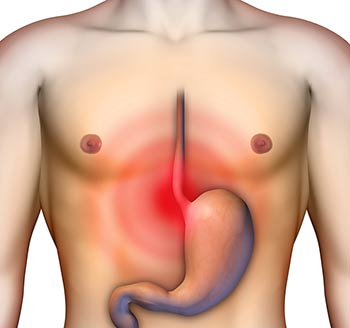 The esophagus is a tube of smooth muscle that transports food from the throat to the stomach. The esophagus starts immediately after the epiglottis, a tissue flap that prevents food from entering the lungs, and ends at the gastroesophageal junction, where the esophagus meets the stomach. The lower esophageal sphincter prevents acidic stomach contents from damaging the esophagus.
The esophagus is a tube of smooth muscle that transports food from the throat to the stomach. The esophagus starts immediately after the epiglottis, a tissue flap that prevents food from entering the lungs, and ends at the gastroesophageal junction, where the esophagus meets the stomach. The lower esophageal sphincter prevents acidic stomach contents from damaging the esophagus.
Normally, a thick lining of squamous cells—tough cells that heal rapidly—protect the interior surface of the esophagus.
Esophageal Disorders
Esophageal disorders can affect any portion of the esophagus, but the area nearest the stomach is the most vulnerable. Esophageal disorders range from chronic heartburn to aggressive esophagus cancer.
Common esophageal disorders include the following:
GERD: GERD, or gastroesophageal reflux disease, results from disorders of the lower esophageal sphincter. Stomach acid enters the esophagus, damaging the esophageal lining and causing chronic heartburn. GERD can cause other esophageal disorders, including dysphagia and esophagus cancer.
Esophageal Dysphagia: Esophageal dysphagia causes food to “stick” in the esophagus on its way to the stomach. Dysphagia is caused by a number of esophageal disorders, including esophageal obstructions such as tumors or birth defects. Motor disorders affecting the smooth muscles of the esophagus also cause dysphagia. While esophageal obstructions usually impair only the transport of solid foods, dysphagia caused by motor disorders can impair movement of both solids and liquids.
Circopharyngeal Incoordination: Circopharyngeal incoordination refers to a dysfunction of the upper esophageal sphincter. The sphincter opens incorrectly, increasing the risk of food entering the respiratory system and causing lung disease.
Achalasia: Achalasia is a motor disorder that affects the smooth muscles of the esophagus, causing dysphagia and relaxation of the lower esophageal sphincter, which increases the risk of esophageal damage due to contact with stomach contents.
Diverticula: Diverticula are abnormal esophageal pockets. Food may become trapped in diverticula, increasing the risk of esophageal infection. Food trapped in diverticula may also be regurgitated when affected individuals lie down.
Esophagus Cancer: Cancer of the esophagus is one of the most serious esophageal disorders. Esophagus cancer is the seventh most common cancer worldwide, although rates vary widely in different countries. Like many esophageal disorders, esophagus cancer often begins in the lower third of the esophagus. Barrett’s esophagus, a GERD complication, is a risk factor for esophagus cancer.
Source: American College of Gastroenterology & Palmetto Digestive Disease






